Agile Coach & Scrum Master Templates
26 templates
Event Storming

Event Storming
Event Storming is a collaborative workshop technique for exploring complex business problems and modeling solutions. It fosters communication, uncovers dependencies, and aligns stakeholders by visualizing the flow of events in a system. This template empowers teams to map out processes, identify bottlenecks, and iterate towards more efficient solutions, driving continuous improvement and innovation.
Team´s High Performance Tree

Team´s High Performance Tree
The Team's High Performance Tree is a visual representation of the factors influencing team performance. It provides a structured framework for identifying strengths, weaknesses, and areas for improvement. By visualizing factors such as communication, collaboration, and leadership, this template enables teams to assess their performance and develop strategies for enhancement, empowering them to achieve peak performance and deliver exceptional results.
Agile Product Roadmap 🚀

Agile Product Roadmap 🚀
Streamline your product development with the Agile Product Roadmap template. Designed for agile teams, it helps you map out product features, set priorities, and track progress in an iterative way. Use it to align your team, manage backlogs, and adjust plans based on feedback and changing requirements. This roadmap is perfect for product managers, developers, and agile coaches aiming to deliver high-quality products efficiently and effectively.
Agile Coach Impact Tree
Scrum Values Assessment
EBM Metric Assessment
Spotify Health Check Template
Utture Practice
Agile Coaching Agreement
Daily Stand-up Meeting Template

Daily Stand-up Meeting Template
The entire team meets to review the day before and discuss the day ahead. These daily meetings, also known as “scrums,” are brief but powerful — they identify roadblocks, give each team member a voice, foster collaboration, keep progress on track, and ultimately keep teams working together effectively. This template makes it so easy for you to plan daily standups for your sprint team. It all starts with picking a date and time, creating an agenda, and sticking with the same format throughout the sprint.
Product Backlog Template

Product Backlog Template
Development teams are often juggling many products at once. A product backlog is a project management tool that helps teams keep track of projects in flight as they build and iterate, so you can store everyone's ideas, plan epics, and prioritize tasks. The highest-priority tasks are at the top of the product backlog, so your team knows what to work on first. Product backlogs make it easier for teams to plan and allocate resources, but it also provides a single source of truth for everyone to know what development teams are working on.
Conversion Funnel Backlog Template
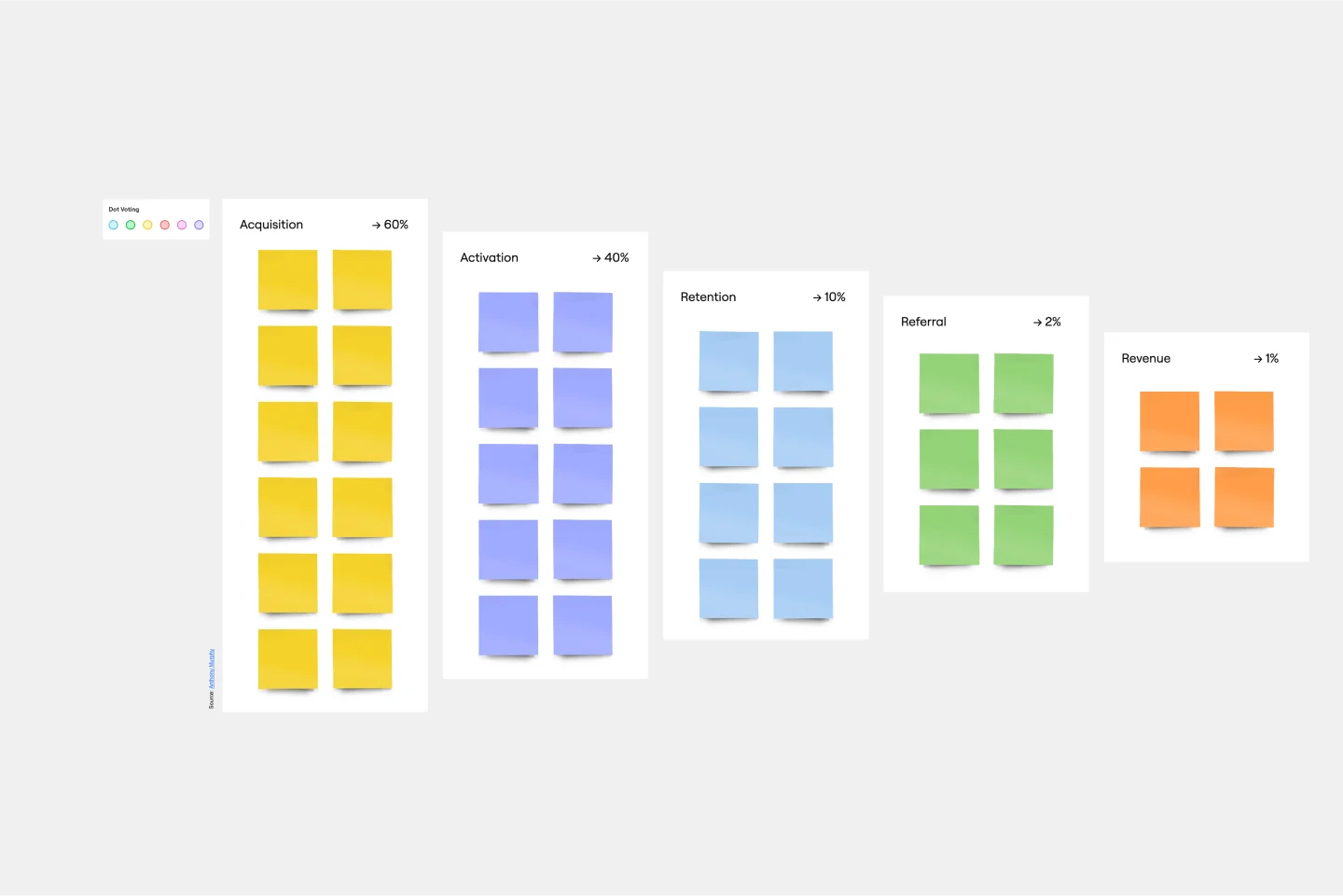
Conversion Funnel Backlog Template
If you’re working on a product that has clear conversions, then it can help to structure your backlog around the conversion funnel to make sure you’re reaching your audience. Creating a conversion funnel backlog brings together information around potential pain-points in your funnel and opportunities for growth. Once you’ve identified that information, it becomes easier to prioritize. You and your team can use the conversion funnel backlog to focus on conversion, retention, and referral, or to tweak your workflow in more mature products.
Agile Board Template

Agile Board Template
Part of the popular Agile framework, an Agile Board is a visual display that allows you to sync on tasks throughout a production cycle. The Agile Board is typically used in the context of Agile development methods like Kanban and Scrum, but anyone can adopt the tool. Used by software developers and project managers, the Agile Board helps manage workload in a flexible, transparent and iterative way. The Agile template provides an easy way to get started with a premade layout of sticky notes customizable for your tasks and team.
Ways We Work - How Agile Are We?
The Ultimate OKR Co-Creation Framework
Idea Funnel Backlog
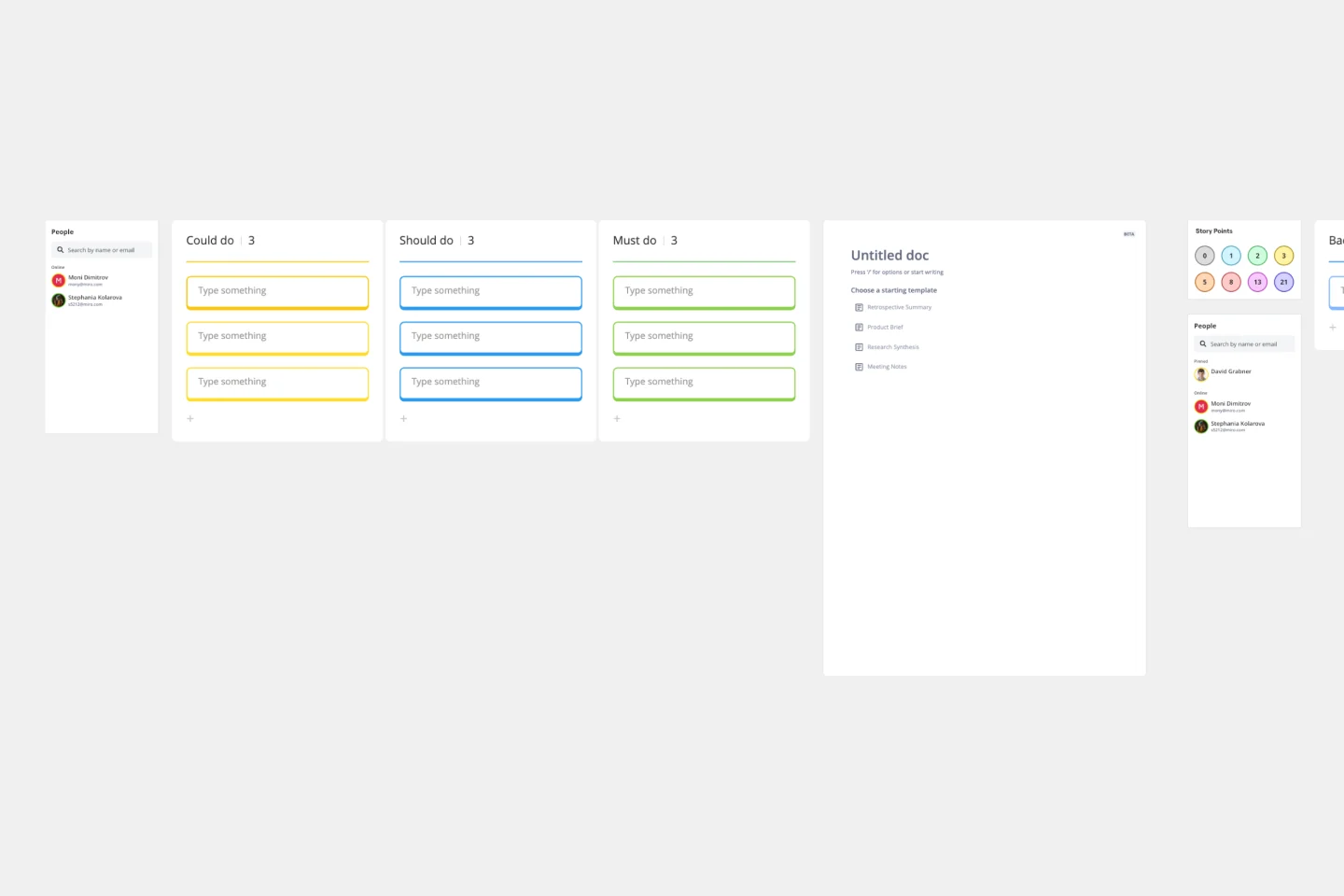
Idea Funnel Backlog
An Idea Funnel Backlog enables you to visualize your backlog and restrict the number of backlogged items at the top. In doing sos, you can prioritize items on your list without having to engage in unnecessary meetings or create too much operational overhead. To use the Idea Funnel Backlog, break up the funnel into different phases or treat it like a roadmap. Use the Idea Funnel Backlog as a hybrid model that combines your roadmap and backlog into one easily digestible format.
Backlog Refinement Template

Backlog Refinement Template
The Backlog Refinement Template in Miro is designed to streamline the process of reviewing, prioritizing, and clarifying upcoming work items. This template integrates seamlessly with Jira, providing a collaborative space for teams to manage their backlog effectively. By using this template, teams can ensure their backlog remains up-to-date and well-organized, facilitating smoother sprint planning and more accurate project forecasting. Key benefits include enhanced collaboration, seamless integration with Jira, time efficiency, and improved prioritization.
Scrum Master Development Map
Agile Coaching Competency Framework
Backlog Refinement with Jira Template
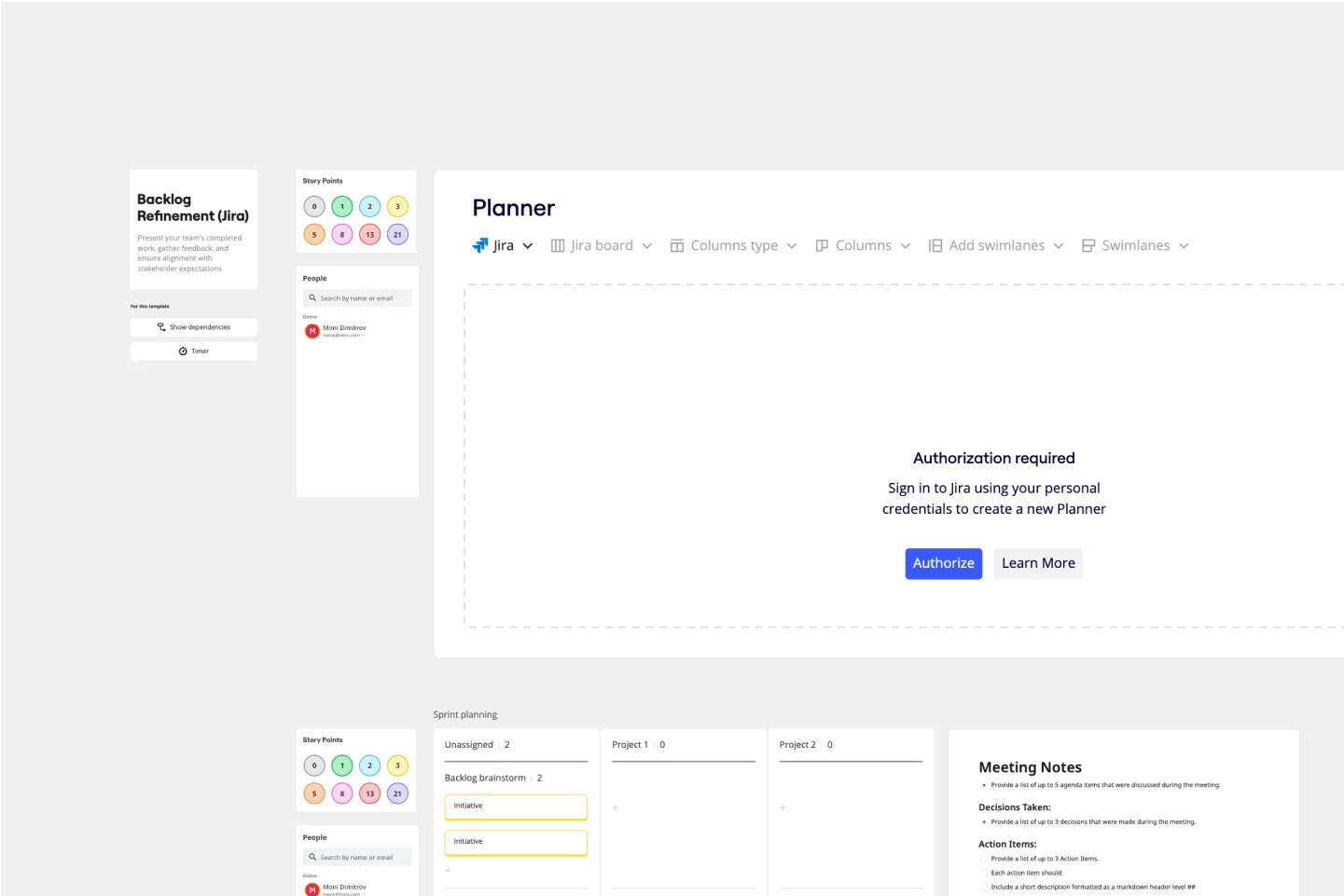
Backlog Refinement with Jira Template
The Backlog Refinement with Jira template in Miro improves collaboration among team members. It provides a visual and interactive space for teams to review, prioritize, and clarify upcoming work items together in real time. This collaborative approach ensures alignment on priorities and details, leading to a more organized and efficient workflow. The seamless integration with Jira automatically syncs all changes, reducing the need for manual updates and keeping both platforms up-to-date.
ART Sync Meeting SAFe Template

ART Sync Meeting SAFe Template
The ART Sync Meeting SAFe Template is designed to streamline your Agile Release Train (ART) sync meetings by combining the Product Owner (PO) Sync and Scrum of Scrums into a single, efficient process. This intelligent template helps you capture meeting insights, document objectives, monitor team progress, and assess program risks. With integrated Miro AI, you can group topics by keyword or sentiment, spotlight key themes, and create summaries for follow-up discussions. This template is customizable to fit your workflow and includes sections for PI Objectives, Program Board, and Program Risks, making it clear that it streamlines SAFe meetings.
Scrum of Scrums Meeting SAFe Template

Scrum of Scrums Meeting SAFe Template
The Scrum of Scrums Meeting SAFe template helps teams coordinate and collaborate effectively across multiple Scrum teams. It includes sections such as the Program Board for visualizing progress and dependencies, SM Updates for team progress updates, Meet After for further discussion topics, Closing for confirming follow-up actions, SoS Agenda for outlining the meeting agenda, and SoS Meeting Area for conducting the main meeting and tracking issues. This template ensures organized, focused, and productive meetings, leading to better coordination and successful project outcomes.
Inspect & Adapt Meeting SAFe Template
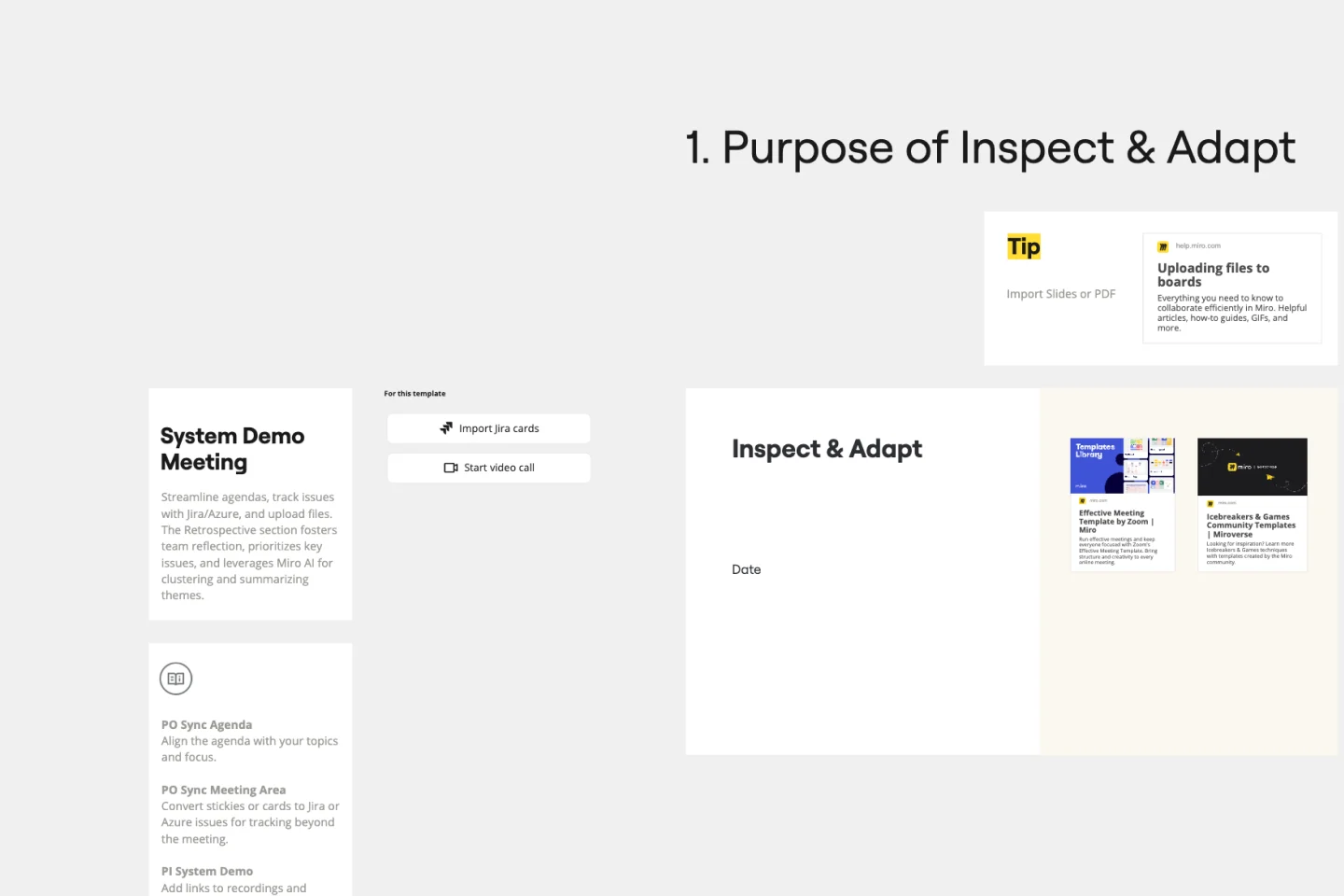
Inspect & Adapt Meeting SAFe Template
The Inspect & Adapt Meeting SAFe template is designed to help teams continuously improve their processes and outcomes. This template is part of Miro's intelligent templates collection, which integrates AI, interactive tools, and seamless integrations to enhance team collaboration and productivity. Whether you are an experienced SAFe practitioner or new to the framework, this template provides a structured approach to conducting effective Inspect & Adapt meetings.
System Demo Meeting SAFe Template

System Demo Meeting SAFe Template
The System Demo Meeting SAFe Template is designed to streamline and enhance the process of demonstrating the integrated work of Agile teams. This template is part of Miro's Intelligent Templates collection, which leverages AI and interactive tools to facilitate efficient and engaging workflows. The System Demo Meeting is a critical event in the Scaled Agile Framework (SAFe), providing a platform for teams to showcase their progress, gather feedback, and align on the next steps.
About the Scrum Master templates collection
This collection serves Scrum Masters and agile coaches facilitating ceremonies across distributed teams. These templates tackle your daily challenges: keeping remote standups focused, extracting genuine insights from retrospectives, making sprint planning collaborative, and helping teams visualize work in ways that surface impediments early.
You'll find templates for every core Scrum ceremony—daily standups, sprint planning, retrospectives, and sprint reviews. Beyond the basics, discover specialized frameworks for backlog refinement, PI planning, team health checks, and dependency mapping.
Why you'll love the Scrum Master templates collection
Visual facilitation cuts through remote meeting fatigue. When your team can see the sprint board, add sticky notes in real-time, and vote on retrospective themes together, participation skyrockets. The interactive canvas keeps distributed team members engaged because they're actively shaping the conversation.
Timeboxing becomes effortless with built-in structure. Templates come pre-configured with frameworks that make ceremonies productive—from the specific questions that guide retrospectives to the swim lanes that keep sprint planning organized. You spend less energy remembering facilitation techniques and more energy coaching your team.
Psychological safety gets a boost from structured participation. Silent brainstorming lets introverted team members contribute before the extroverts dominate. Anonymous voting reveals what the team truly thinks without groupthink pressure. These techniques help you create the safety needed for honest conversations about what's not working.
Ceremony artifacts become living documentation. Your retrospective action items don't disappear into forgotten meeting notes. Sprint goals stay visible throughout the iteration. Your definition of done evolves on the same board where you plan work. This continuity means insights from ceremonies actually influence daily work.
How to use the Scrum Master templates
Step 1: Pick your ceremony starting point. Select the template that matches your immediate need—whether you're preparing for tomorrow's retrospective or setting up your first PI planning session.
Step 2: Customize for your team's reality. Adjust retrospective questions to target current challenges. Modify the sprint planning board to match your team's definition of ready. Add swim lanes for different work types. Make the framework relevant to your specific team dynamics.
Step 3: Set up before the ceremony. Populate the board with context your team needs. Add sprint goals, copy over backlog items, or pre-fill retrospective themes based on what you've observed. This prep work means you can facilitate instead of scrambling during the ceremony.
Step 4: Facilitate with confidence. Use Miro's timer to keep activities timeboxed, enable voting to democratize prioritization, and activate presentation mode when you need focused attention. The template structure keeps conversations on track while letting you adapt when unexpected insights emerge.
Step 5: Capture and carry forward. Document decisions and action items directly on the board. Take screenshots of key outcomes to share with stakeholders. Transform retrospective experiments into the next sprint's board.
FAQ about Scrum Master templates
How do these templates work for teams new to agile?
The templates provide clear structure that helps teams understand what each ceremony accomplishes without overwhelming them with theory. Visual frameworks make abstract agile concepts concrete—your team can literally see the sprint backlog, watch work move through stages, and understand dependencies at a glance.
Can I use these templates if my team doesn't follow textbook scrum?
Absolutely. Most teams blend Scrum with Kanban elements or adapt practices to their organization's reality. These templates work as flexible starting points, not rigid rules. Change retrospective formats, combine ceremonies, or adjust timing to match what works for you.
How do I get remote team members to actually participate in ceremonies?
The interactive nature of these templates naturally increases engagement. When team members can add their own sticky notes, vote on priorities, and see their contributions appear in real-time, they become active participants. Use timers to create urgency and enable anonymous input when discussing sensitive topics.
Ready to facilitate agile ceremonies that your team actually looks forward to? Explore the Scrum Master templates and transform your next sprint into the collaborative, high-performing experience agile promises.











